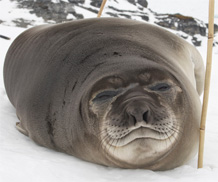Polar science: History, modern research and film-making
With Alice Courvoisier, Mark Brandon and James Chong
 An elephant seal, courtesy James Chong
An elephant seal, courtesy James Chong
- Thursday 20 June 2013, 6.30PM
- Free admission
Booking required, see below for tickets - Ron Cooke Hub, University of York (See locations page)
Event details
Scientists have long looked to the Polar regions to find answers to complex global questions, but what conclusions did they reach? What is the reality of Antarctic research today? And how easy is it to explain this to the viewing public in programmes such as Frozen Planet? Polar experts and an academic advisor to the BBC series discuss.
Taking Newton's ideas North & South: the story of the French expeditions that measured the length of the degree of the meridian arc.
Alice Courvoisier
At the beginning of the 18th century, a controversy concerning the shape of the Earth had arisen: was it flattened at the pole, as Newton's theories predicted, or elongated, as French astronomer Jacques Cassini's geodetic measurements suggested? With the blessing of King Louis XV, the French Royal Academy of Sciences prepared for two twin expeditions, one to Peru, near the Equator, the other to Lapland by the Arctic Circle. Both would measure the length of a degree of latitude: if it proved longer near the pole, Newton would be vindicated.
Pierre Louis Moreau de Maupertuis was leading the Lapland expedition, which lasted from July 1736 to June 1737. Assisted by the locals, Maupertuis and his team successfully completed their mission, despite the summer mosquitoes and the fiendishly cold winter. In the meantime, the scientists of the Peru expedition had to contend with bad weather, sickness, the hostility of the natives and of the Spanish colonists, as well as internal dissensions. The leaders, Pierre Bouguer and Charles Marie de La Condamine, returned to France separately nearly ten years after they had left.
This talk will address the background to the expeditions, the challenges faced by the scientists in extremely demanding conditions, and their results, which ultimately proved Newton correct.
Frozen Planet: advising on the science in the BBC hit series
Mark Brandon
The Open University was a co-production partner in Frozen Planet and members of the University were working on the series since early 2008. Mark has spent years working in the Arctic and Antarctic and he will talk about his experiences of the production process, going on a shoot in the Arctic, the production of associated teaching course, and how science was the driving force throughout.
Seven weeks south: A journey to Signy Island
James Chong
Signy Island is only just inside the Antarctic Circle but, due to a lack of runways, takes some considerable time to reach. James Chong will talk about his recent British Antarctic Survey-sponsored journey South, the wildlife, what it was like spending Christmas on a small island with seven other individuals, and why setting up simple experiments on a glacier is not quite as easy in real life as it sounds on paper.
Website: sevenweekssouth.blogspot.co.uk

